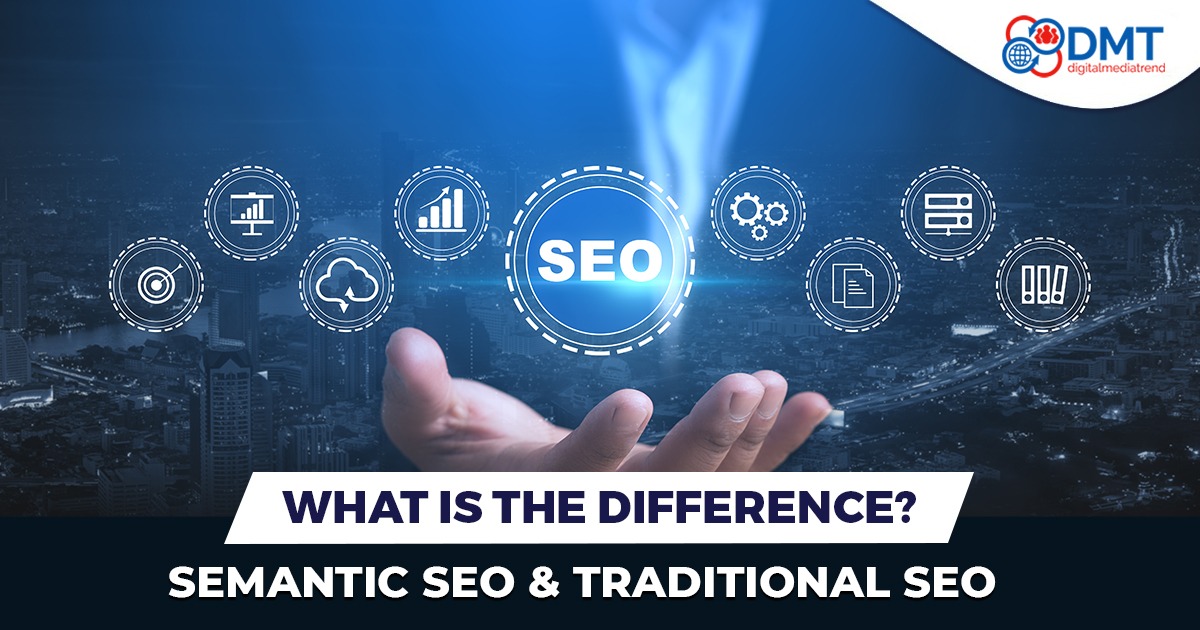Search Engine Optimization (SEO) is crucial for online visibility and traffic generation. Over the years, SEO has evolved from keyword-centric strategies to more sophisticated approaches. Two significant paradigms in SEO are Traditional SEO and Semantic SEO. This article explores the differences between these two approaches, delving into their methodologies, tools, and impacts on search engine results.

Traditional SEO
- Focus on Keywords:
Traditional SEO primarily revolves around keyword optimization. Keywords are the phrases or terms that users enter into search engines to find information. The core activities include:
- Keyword Research: Identifying high-volume and relevant keywords.
- Keyword Density: Ensuring a certain percentage of keywords within the content.
- Meta Tags: Using keywords in meta titles, descriptions, and header tags.
- Backlinking: Acquiring backlinks with keyword-rich anchor text.
- Content Optimization:
- Content in traditional SEO is often optimized for specific keywords. This involves:
- Exact Match Keywords: Using exact match keywords multiple times within the content.
- Keyword Stuffing: Overloading content with keywords to rank higher (often penalized today).
- On-Page SEO: Optimizing individual page elements, including title tags, headers, and image alt texts.
- Technical SEO:
- Technical aspects in traditional SEO focus on:
- Site Speed: Ensuring fast load times.
- Mobile Friendliness: Ensuring websites are mobile-optimized.
- Crawlability: Making sure search engines can crawl and index the site effectively.
- Structured Data: Using schema markup to help search engines understand the content.
- Link Building:
- Traditional SEO heavily relies on link building, which involves:
- Quantity of Links: The more backlinks a site has, the better it ranks.
- Link Quality: Acquiring links from high-authority sites.
- Anchor Text Optimization: Using keywords in the anchor text of backlinks.
Semantic SEO
- Focus on Context and Intent:
Semantic SEO moves beyond keyword-centric strategies and emphasizes understanding the context and search intent behind queries. This involves:
- User Intent: Analyzing what the user intends to find with their search.
- Contextual Relevance: Creating content that answers the broader context of a query.
- Semantic Relationships: Understanding relationships between words and concepts.
- Content Optimization:
Content under semantic SEO is optimized for relevance and comprehensiveness rather than just keywords. This involves:
- Topic Clusters: Creating content that covers entire topics comprehensively.
- Latent Semantic Indexing (LSI) Keywords: Using related terms and synonyms.
- Natural Language: Writing in a natural, conversational style that addresses user queries.
- Technical SEO:
Technical aspects in semantic SEO are advanced, focusing on:
- Structured Data: Extensively using schema markup to define entities, actions, and relationships.
- Entity-Based SEO: Focusing on entities (people, places, things) rather than just keywords.
- Knowledge Graph Integration: Enhancing visibility in the Knowledge Graph.
- User Experience:
- Semantic SEO places a strong emphasis on user experience (UX), including:
- Content Quality: High-quality, informative content that fully answers user questions.
- User Engagement: Designing for better user engagement metrics such as time on site, bounce rate, and page views.
- Accessibility: Ensuring content is accessible to all users, including those with disabilities.
- Semantic SEO Link Building:
- Quality Over Quantity: Emphasizes earning links from high-authority, relevant sites.
- Techniques: Focuses on creating valuable, engaging content that others want to link to.
- Benefits: Results in sustainable link profiles and avoids penalties from search engines.
Key Differences
- Approach to Keywords:
Traditional SEO: Prioritizes exact match keywords and their density within the content.
Semantic SEO: Focuses on the meaning and intent behind keywords, using related terms and synonyms to provide a holistic answer to user queries.
- Content Creation:
Traditional SEO: Content is created with a focus on fitting in specific keywords.
Semantic SEO: Content is created with a focus on addressing user intent and providing comprehensive coverage of topics.
- Technical Focus:
Traditional SEO: Basic technical aspects like site speed, mobile-friendliness, and crawlability.
Semantic SEO: Advanced techniques like structured data, entity optimization, and enhancing the Knowledge Graph presence.
- User Experience:
Traditional SEO: Less emphasis on user experience, more on keyword and link metrics.
Semantic SEO: High emphasis on user experience, engagement metrics, and content accessibility.
- Link Building:
Traditional SEO: Focus on acquiring as many high-quality links as possible.
Semantic SEO: Focus on earning links through high-quality, authoritative content that naturally attracts backlinks.
In the ever-evolving world of digital marketing, staying ahead requires embracing advanced SEO techniques. DMT Lahore provides the expertise, training, and services needed to implement Semantic SEO effectively. By focusing on high-quality, authoritative content and understanding user intent, DMT Lahore helps businesses achieve sustainable growth and improved online visibility. Whether you’re looking to upgrade your skills or optimize your website, DMT Lahore is your partner in mastering Semantic SEO.

